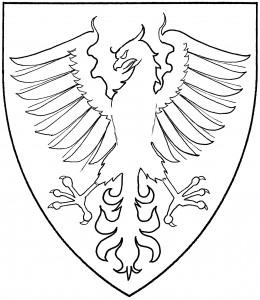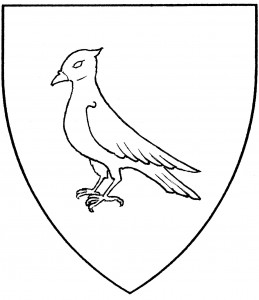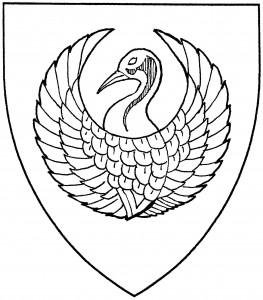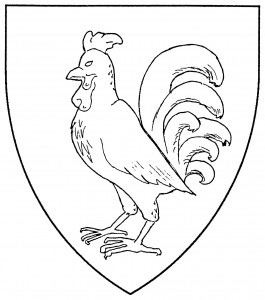The eagle is the monarch of the birds, the medieval symbol of majesty and vision (literally and figuratively). It is thus a frequent charge in medieval armory, dating from the earliest heraldic records, as in the arms of the Kingdom of Germany, c.1244 [ANA2 193]. More than any other bird of heraldry, it is drawn in a highly stylized manner: with a crest, ruffled feathers, and ornate wings and tail. German emblazons may add klee-stengeln, wing-bones, and they are sometimes explicitly blazoned; they are considered artistic details.
The eagle is displayed by default; however, the form of display may differ according to time and place. In later-period England, eagles displayed held their wings with their tips up; while in early Germany, eagles displayed had the wingtips down, in the posture called “displayed inverted” in English. As the distinction is mostly one of emblazonry, it is granted no heraldic difference, and indeed is usually left unblazoned.
A variant of the eagle is the “alerion” or “allerion”, a beakless, footless eagle found in the arms of the Duchy of Lorraine; this form had been recognized as a variant by the end of our period [de Bara 213]. It may only be shown displayed.
Double-headed eagles are also found, most famously in the arms of the Holy Roman Emperor c.1220 [Asp2 34], but also in lesser armory such as Bluet, c.1282 [ANA2 196]. (As the Imperial eagle was shown through history with either one or two heads, no difference is granted for the number of heads.) Triple-headed eagles are not permitted, by Society precedent. For related charges, see falcon, phoenix, roc, vulture.
The Award of the Alerion, of the Barony of Lochmere, bears: Per fess engrailed azure and argent, an alerion counterchanged.
Al Altan bears: Or, three eagles gules.
John Aquila of Eaglesdown bears: Purpure, an eagle close to sinister Or.
Andrei de Sevastopol bears: Gyronny argent and gules, a double-headed eagle displayed sable.






